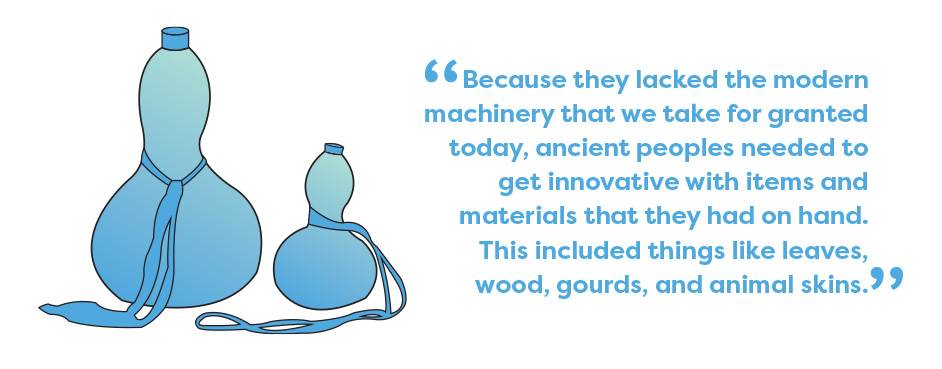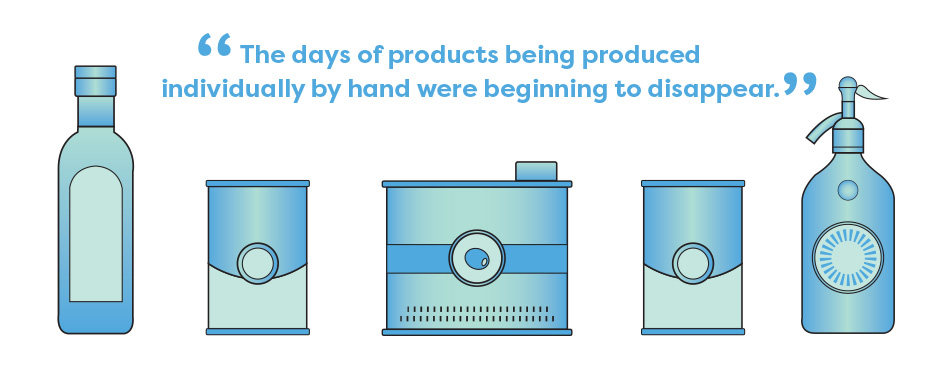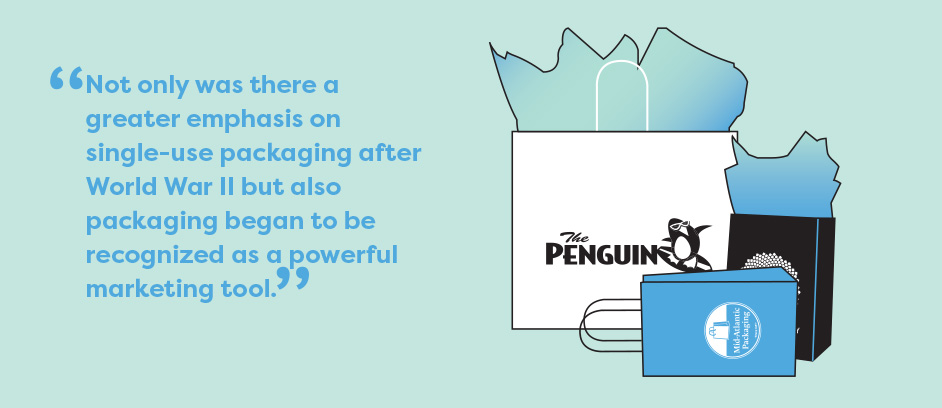The Evolution of Packaging
Posted by Julie Rotuno on 14th Jun 2022
What does packaging do for your company? In other words, is it only intended to protect its contents? Or, does packaging do even more, such as:
- Containing;
- Preserving;
- Advertising; and
- Communicating?
Modern packaging is incredibly functional, versatile, and attractive. Packaging has improved so much in recent years that it’s a little bit difficult to look back and recall how things used to be. Even obscurer is the earliest days of packaging. What did ancient people do when they wanted to pack up and move?
Let’s take a survey of the evolution of packaging to better understand where we’ve been, where we are, and where we are going.

Ancient Packaging
Eons before the development of kraft paper, corrugated cardboard, and reusable shopping bags, people had little use for packaging of any kind. That is mainly because ancient people tended to stay in centralized areas. They didn’t move around much, and the food that they ate was prepared and immediately consumed. The technology for preserving food over long time periods did not exist.
Eventually, ancient people became more nomadic. Their cultures were becoming increasingly sophisticated, and they were seeking ways to better ensure their survival. Driven by the scarcity of food, these people needed to find ways to pack up and move with food and other essential items.
Because they lacked the modern machinery that we take for granted today, ancient peoples needed to get innovative with items and materials that they had on hand. This included things like leaves, wood, gourds, and animal skins.
For example, ancient people may have used large leaves from a variety of plants and trees, binding them together with vines to create bags or sacks. They further discovered that the tanned hide of an animal that was killed for a meal was useful for transporting a variety of goods.
As the decades passed, people began to domesticate animals. This led to the creation of villages. With the rise of established communities, it became clear that improved storage and transportation methods were needed.
Packaging Advancements with the Rise of Villages
As more and more people abandoned their nomadic lifestyles in favor of living in settled communities, they began developing new and better ways to store food and other items. Among these innovations were clay pots. People also began using plant fibers to weave baskets, and bags that were made from animal skins became more sophisticated and durable. Some civilizations even began fashioning wooden crates and boxes.
The Establishment of Cities
While some communities remained small and remote, others grew in leaps and bounds. It became more common for people to travel from one city to another on trading expeditions. Packaging solutions that included wooden barrels, glass, and paper began to make an appearance.
In ancient Egypt, people developed glass blowing. Initially considered a precious stone that was only used by royalty, people eventually began using glass containers to store food and water.
Meanwhile, in ancient China, people were rapidly developing paper technology. This means that the Chinese are credited with developing flexible packaging. Researchers believe that the Chinese were treating mulberry bark to use as a wrap for food as early as the first or second centuries. Later, the Chinese would use their innovations to package items like tea and medicine.
During the medieval period, boxes and barrels made of wood became staple items in the packaging industry. Barrels could even be used to transport liquids and dried food across oceans.

The Industrial Revolution
Between approximately 1760 and 1840, the world was utterly transformed by the Industrial Revolution. New, improved manufacturing processes were springing up across Europe and the United States. The days of products being produced individually by hand were beginning to disappear. Now, factories were being constructed, and these modern facilities featured advanced new machines that might be powered by water or steam.
With the industrial boom came an even greater need for innovative and advanced packaging ideas. Unfortunately, many of these packaging advancements were quite expensive, which meant that their use was almost always reserved for transporting luxury items to wealthy people.
During the Industrial Revolution, Napoleon Bonaparte was seeking an improved method for transporting food to his hungry troops. The year was 1795, and Napoleon announced that 12,000 francs would be paid to any inventor who could create a better food preservation system. It took 15 years for a chef and inventor named Nicolas Appert to claim the prize. Frequently recognized as the father of canning, Appert invented a method of food preservation that involved boiling and sealing food in airtight containers made of glass. This method was so effective that it is still used today for preparing canned foods.
Also during the Industrial Revolution, an inventor named Peter Durand obtained a patent on iron cans coated with tin. The tin-coated cans were used to keep food, and within just two decades, tin became a popular packaging choice for products ranging from tobacco to cookies.
The Industrial Revolution also saw the invention of the cardboard box. Although the Chinese had invented cardboard centuries earlier, it took until 1817 for the material to be fashioned into a box by inventor Sir Malcolm Thornhill. These boxes were not corrugated. That invention did not make an appearance until some decades later in 1871.
Cardboard boxes didn’t really enjoy widespread use until the 1890s when a more efficient method for making prefabricated cartons was developed. Well-known U.S. brands like Kellogg’s and NABISCO quickly adopted the packaging for their cereals and cookies.
The Late 19th to Early 20th Centuries
Along with cardboard boxes making an appearance on grocery store shelves, this also was the era when the first paper bag-making machine was developed. Shaped more like large mailing envelopes than the bags that are familiar to today’s consumers, these packaging items became widely used for many years.
Cellophane also was developed during this era. A Swiss chemist named Jacques E. Brandenberger is believed to have come up with the innovation in 1908. He was trying to make a cloth that did not absorb liquids. Initially, he used wood cellulose to manufacture his creation. Cellophane remained incredibly popular up through the 1950s and 1960s because of its transparency. In fact, many historians credit cellophane with giving rise to the more recent popularity of plastic packaging.
Other innovations of the era include the Gable-top milk carton, frozen food packaging and the pop-top aluminum can.

Later in the 20th Century
In the decades following the conclusion of World War II, the packaging industry gravitated more toward single-use materials like plastics and aluminum foil. Bubble wrap was invented in 1957, and PET plastic bottles made an appearance in 1973. PET plastic was perfect for holding carbonated drinks, and because it was much cheaper than glass, this became the material of choice for soft drink manufacturers.
Packaging Today
Not only was there a greater emphasis on single-use packaging after World War II but also packaging began to be recognized as a powerful marketing tool. This means that most items today are packaged in paper- or plastic-based packaging that can showcase critical information like:
- The manufacturer’s name
- A recognizable logo
- Nutrition, material or ingredient information
- Data about where the product was made
- Expiration dates
- How to contact the company
However, consumers are showing a desire to shift away from single-use packaging that cannot be recycled or otherwise reused. This has led to important advances in the realm of sustainable packaging.
More people are beginning to worry about climate change and the environment in general. Accordingly, they are seeking eco-friendly products that are packaged in an environmentally responsible way. Demand for packaging material that can easily be reused or recycled is growing, and it’s wise for companies to pay attention.
When it comes to choosing sustainable packaging, it’s necessary to consider what happens after the package has been used for its intended purpose. However, it also is wise to think about the source of the materials used to manufacture the packaging. For instance, you may want to look for packaging that is made from recycled materials or that is derived from a verified green supplier.
We’re also seeing a trend toward greater use of smart packaging. This innovative type of packaging features embedded sensor technology that enables functionalities like moisture control or enables the package’s ability to indicate its status.
RFID tags, QR codes, and NFC chips are all being incorporated into smart packaging. Thanks to these digital tools, it is easier than ever to guarantee that a product maintains its integrity and quality throughout its life cycle.
Ask Mid-Atlantic Packaging About Tomorrow’s Innovations
If you are looking for ways to improve your company’s packaging choices, then contact Mid-Atlantic Packaging today at (800) 284-1332 or visit our website and browse our intensive catalog of packaging material. We’re experts on the past, present, and future of the packaging industry.



